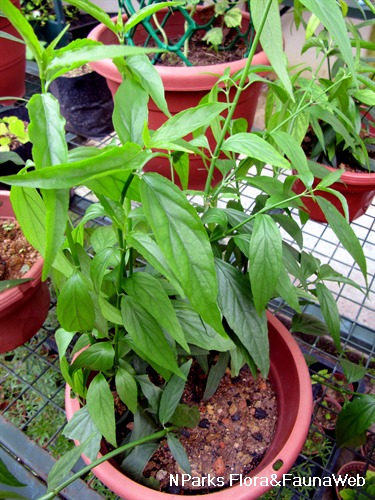
Back
Clinacanthus nutans (Burm. f.) Lindau
| Family Name: | Acanthaceae |
| Synonyms: | Clinacanthus burmanni Nees in DC |
| Common Name: | Sabah Snake Grass, 优顿草 |
Name
Classifications and Characteristics
| Plant Division | Angiosperms (Flowering Seed Plants) |
|---|---|
| Plant Growth Form | Shrub |
| Lifespan (in Singapore) | Perennial |
| Mode of Nutrition | Autotrophic |
| Plant Shape | Irregular |
| Maximum Height | 1 m to 3 m |
Biogeography
| Native Distribution | From China, Thailand, Vietnam, Malaysia and Indonesia. |
|---|---|
| Native Habitat | Terrestrial (Grassland / Savannah/ Scrubland) |
| Preferred Climate Zone | Tropical |
| Local Conservation Status | Non-native |
Description and Ethnobotany
| Growth Form | It is a scandent shrub, with upright branches drooping over, about 1-3 m tall. |
|---|---|
| Foliage | Its simple, opposite, stalked leaves are lanceolate-ovate, lanceolate to linear-lanceolate, 4-12 cm long by 1-4 cm wide. |
| Flowers | Its dull red to orange red flowers are about 3.2 cm long, with a green base, borne in dense terminal racemes. |
| Fruit | Its fruits are in the form of a capsule, 2 cm long, shortly hairy. |
| Habitat | It grows in thickets. |
| Associated Fauna | Its flowers are probably pollinated by insects or birds. |
| Cultivation | It can be propagated by seed or stem cutting. |
| Etymology | Greek klinh, prostrate, bed, Latin Acanthus, after Acantha, a nymph loved by the Greek God Apollo who was changed into an Acanthus plant. Latin nutans, drooping, nodding, referring to the drooping form of the branches and leaves. |
| Ethnobotanical Uses | Medicinal: Scientific Evidence of Medicinal Properties In pre-clinical trials, Sabah Snake Grass showed pain-relieving (Zakaria et al., 2018), anti-cancer (Rahman et al., 2019), anti-diabetic (Retnaningsih et al., 2019), anti-inflammation (Wanikiat et al., 2008), and antioxidant (Rahman et al., 2019) properties in animals. Traditional Medicinal Uses Research supports the traditional use of Sabah Snake Grass to treat insect / snake bites, skin rashes, herpes simplex virus-induced lesions, diabetes and gout in Malaysia, Indonesia, Thailand and China. It is important to note that some therapeutic effects from traditional medicinal uses of plants are not currently supported or verified by scientific research.
|
Landscaping Features
| Landscape Uses | Flowerbed / Border |
|---|---|
| Thematic Landscaping | Economic Garden |
Fauna, Pollination and Dispersal
| Pollination Method(s) | Biotic (Fauna) |
|---|---|
| Seed or Spore Dispersal | Abiotic |
Plant Care and Propagation
| Light Preference | Full Sun, Semi-Shade |
|---|---|
| Water Preference | Moderate Water |
| Plant Growth Rate | Moderate |
| Rootzone Tolerance | Moist Soils, Well-Drained Soils, Fertile Loamy Soils |
| Propagation Method | Seed, Stem Cutting |
Foliar
| Foliage Retention | Evergreen |
|---|---|
| Mature Foliage Colour(s) | Green |
| Mature Foliage Texture(s) | Leathery |
| Foliar Type | Simple / Unifoliate |
| Foliar Arrangement Along Stem | Opposite |
| Foliar Attachment to Stem | Petiolate |
| Foliar Shape(s) | Non-Palm Foliage (Lanceolate, Elliptical) |
| Foliar Venation | Pinnate / Net |
| Foliar Margin | Entire |
Floral (Angiosperm)
| Flower & Plant Sexuality | Bisexual Flowers |
| Flower Colour(s) | Red, Orange |
|---|---|
| Flower Grouping | Cluster / Inflorescence |
| Flower Location | Terminal |
| Inflorescence Type | Raceme |
Fruit, Seed and Spore
| Mature Fruit Colour(s) | Brown |
|---|---|
| Fruit Classification | Simple Fruit |
| Fruit Type | Dehiscent Dry Fruit , Capsule |
References
| References | Rahman, N.M.A.N.A., Nurliyana, M.Y., Afiqah, M.N.F.N.N., Osman, M.A., Hamid, M. & Lila, M.A.M. (2019). Antitumor and antioxidant effects of Clinacanthus nutans Lindau in 4 T1 tumor-bearing mice. BMC Complementary and Alternative Medicine 19: Article ID 340. Retnaningsih, C., Ananingsih, V.K., Meiliana, Anggraeny, E.N., Cahyani, I.M., Nugraheni, B. & Efendi, R. (2019). The effect of Clinacanthus nutans (Burm.f.) Lindau water fraction addition on hypoglycemia. IOP Conference Series: Earth and Environmental Science 292: Article 012032. Wanikiat, P., Panthong, A., Sujayanon, P., Yoosook, C., Rossi, A.G. & Reutrakul, V. (2008). The anti-inflammatory effects and the inhbition of neutrophil responsiveness by Barleria lupulina and Clinacanthus nutans extracts. Journal of Ethnopharmacology 116(2): 234–244. Zakaria, Z.A., Rahim, M.H.A., Roosli, R.A.J., Sani, M.H.M., Omar, M.H., Tohid, S.F.M., Othman, F., Ching, S.M. & Kadir, A.A. (2018). Antinociceptive activity of methanolic extract of Clinacanthus nutans leaves: Possible mechanisms of action involved. Pain Research and Management Article ID 9536406. |
|---|
Image Repository
Others
| Master ID | 31260 |
|---|---|
| Species ID | 5655 |




